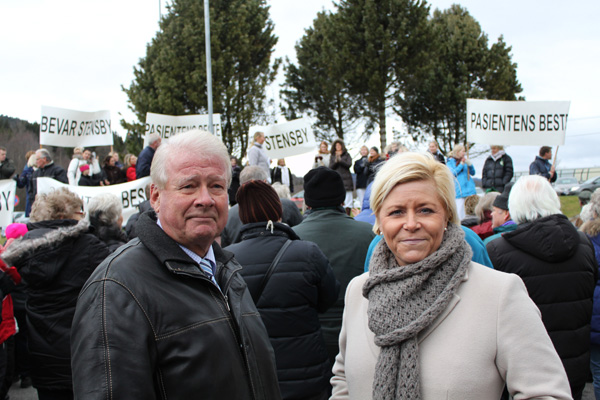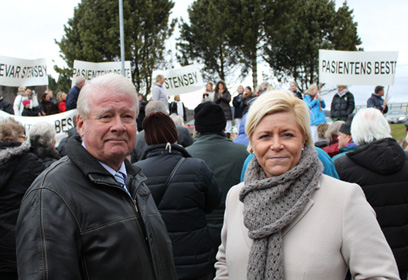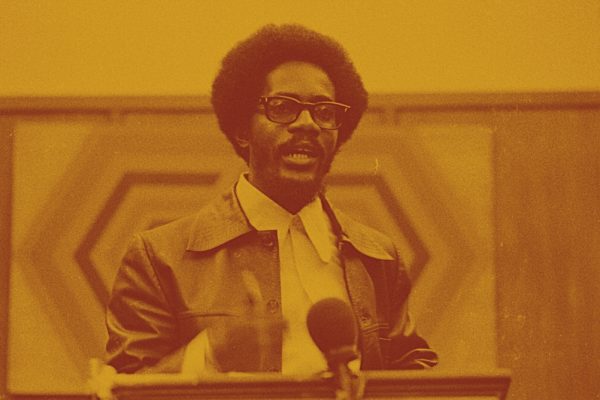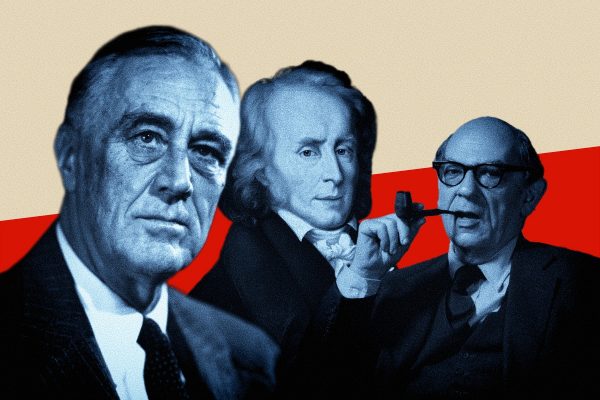
Carl Hagen, former chairman of Norway's populist right-wing Progress Party, and Siv Jensen, the party's current leader and Norway's finance minister. Photo: Fremskrittpartiet
Across Europe, the hold of traditional centrist parties—whether social democratic, liberal, or conservative—seems to be slipping away. In the wake of popular discontent with widening socioeconomic inequalities, financial austerity, and mass youth unemployment, the post-World War II political settlement is, if not in ruins, certainly shattered. There is a real sense of crisis of political and democratic legitimacy. Polarization and marginalization have increased the appeal of extremism, whether in the form of Salafi jihadism among disaffected Muslim youth or right-wing extremism among non-Muslim youth. Notwithstanding the recent successes of Syriza in Greece and Podemos in Spain, in many countries it has been the far and populist right which has gained the most traction, from Marine Le Pen’s Front National in France to Nigel Farage’s United Kingdom Independence Party in Britain, Pegida in Germany, Geert Wilders’s Party for Freedom in the Netherlands, the Swedish Democrats, and the True Finns.
As the political scientist Cas Mudde has noted, these developments are highly uneven across the continent. In many southern European countries with authoritarian Cold War legacies, far- and populist right parties hold little electoral appeal, despite the fact that some of these countries have been among the greatest victims of the ongoing financial crisis. But the return of far- and populist right mass mobilizations a mere twenty-five years after the unfounded liberal optimism of 1989 raises profound and troubling questions for European societies. The rise of the populist right in Norway, in particular, suggests that technocratic elitism and increasing inequality are as much a challenge for parties loudly proclaiming to represent the interests of ordinary people as they are for established centrist parties.
• • •
We know quite a lot about the factors associated with far- and populist right political formations. In general, such voters are more likely to be white, working- or service-class, older, male, and poorly educated than the voters of established mainstream parties. And at a time in which international humanitarian organizations have declared that the world faces its worst refugee crisis since World War II, and thousands drown in the Mediterranean every year in desperate attempts to reach European shores, it is immigration above all that has exercised the minds of European far and populist right voters. This is not surprising, given that far- and populist right political actors across Western Europe have been remarkably successful in propounding over the last three decades what the political scientist Mahmood Mamdani has referred to as a “culturalization of politics”: societal problems have come to be understood in cultural and religious, rather than economic, terms. It is the culture or religion of immigrants, rather than labor market discrimination or socioeconomic deprivation, that is supposed to explain their failure to “integrate.”
Norway's government now openly celebrates a declining number of asylum seekers.
It is notable that the populist far-right in Western Europe has learned the language of liberal values and exploited it to reach a wider demographic. The Danish sociologist Sune Laegaard has referred to this as a “nationalisation of liberal values.” It has become commonplace for far- and populist right politicians to declare themselves champions of gay and lesbian rights—as well as women’s rights, which have long served as an exceptionally useful and blunt instrument to be wielded against patriarchal minorities. But we know more about what these parties look like in opposition than in power. A central question for any far- or populist right party which wants to achieve power is how to “turn rebelliousness into policy.”
This is why the experience of small and peripheral Norway, with a population of only 5 million, is significant. In the parliamentary elections of September 2013, the populist right-wing Progress Party (Fremskrittspartiet, FrP) came to power as a junior partner in a coalition government with the Conservative Party (CP). The FrP’s precursor was established by the libertarian maverick, populist right newspaper man, and apartheid supporter Anders Lange as an anti-taxation and anti-bureaucratic party in 1973. It discovered the electoral appeal of anti-immigrant and anti-Muslim sentiment in 1987, when chairman Carl I. Hagen read out a fabricated letter purportedly penned by a Norwegian Muslim threatening a future Muslim “takeover” in the course of that year’s county election campaign. The letter was an early instance of far-right and Islamophobic fears about “Eurabia,” which would later influence the Norwegian right-wing extremist Anders B. Breivik, who killed seventy-nine people in the worst terrorist attack in Norwegian history on July 22, 2011. Four years later, Norwegians risk both censure in the media and threats from far-right sympathizers for pointing out that Breivik was actively involved with the Progress Party for ten years from 1997 to 2006, when he withdrew from society and, as John Bowen has written, “drenched himself in the writings of far-right, anti-Islam activists from the United States and Europe.”
Mainstream political parties in Norway long maintained a cordon sanitaire against the FrP. The idea of a political alliance between the FrP and the CP was first mooted by CP politicians on the City Council of Oslo in 1990, when the two parties collaborated closely in order to secure right-wing dominance of the council from that year onward. By 2009, CP strategists had concluded that their party’s electoral future lay in a political partnership with the FrP. It was by all means an alliance of strange political bedfellows. The CP’s voters have the highest levels of education and income compared to voters of any other party; the FrP’s voters are among the least educated and most likely to receive social benefits. But on some policy areas—especially immigration—their electorates’ views converged.
The result has been that the country of Fridtjof Nansen has become one in which the government now openly celebrates a declining number of asylum seekers. “These are very positive figures,” declared FrP spokesperson Mazyar Keshvari in commenting on statistics indicating that the number of asylum claimants in Norway in the first quarter of 2015 had dropped by 22 percent from the previous year. “The reason why the figures are dropping is that the Progress Party is in power,” Keshvari added. Since coming to power, the government has also deported a significant number of underage children of asylum seekers to countries to which the UN High Commissioner for Refugees (UNHCR) cautions against returning people. There are an estimated 9 million Syrian refugees and internally displaced persons; Lebanon has accepted 1.5 million of them, but in 2014 the Norwegian government shut its doors on 123 Syrian refugees, who had already been accepted by the UNHCR, on the grounds that they were too mentally and physically ill from having lived through the hell of civil war. In February 2015, the government of Afghanistan resigned from an agreement with the government of Norway to accept repatriation of Afghan asylum seekers whose applications had been turned down by Norwegian authorities, on the grounds that 84 Afghan minors had been forcibly deported from to Afghanistan in 2014 despite warnings from both the UNHCR and the Afghan government about an increasingly unsafe and unstable Afghanistan. In the run-up to the party’s annual congress, FrP members of parliament declared that they wanted to abolish the right to seek asylum in Norway altogether and would work to alter the UN’s Refugee Convention from 1951. Representatives of the Norwegian government have recently begun negotiations with Eritrea to forcibly deport thousands of refugees who have already been granted the right to stay in Norway.
These arguments and measures appeal to the extreme right-wingers who have long been part of the FrP’s constituency. A 2009 national representative survey conducted by the Institute for Social Research in Oslo found that 16 percent of those who expressed electoral preferences for the FrP self-identified as belonging to the “extreme right,” and as I have documented in Anders Breivik and The Rise of Islamophobia (2014), the FrP’s political discourse on Islam, Muslims, and immigration in the years 1987 to 2011 drew on ideas and arguments to a large extent borrowed from the extreme right in Europe at large. Mirroring what sociologist Christopher Bail has called the “fringe effect” of anti-Muslim discourse in the wake of 9/11, anti-Islam and anti-immigration arguments that were previously the preserve of the far-right fringe have become part of Norway’s political mainstream.
The opposition Labour Party, the social liberal party Venstre, and the Christian Democratic Party (Kristelig Folkeparti, KrF) have all committed to increasing the current government’s current UN quota refugee cap from 1,500 to 5,000 per year. By contrast, during its party congress in May, FrP parliament members insisted that Norway should accept no quota refugees. Academics who have studied the rise of the FrP argue that the party’s stance on immigration and integration is the most central element of its electoral appeal. It also happens to be the policy area in which the FrP has wielded the greatest influence on other political parties: since the 1990s, both the social democratic Labour Party and the Conservative Party have shifted their discourse in attempts to shore up support. But as pointed out in a recent doctoral dissertation on the Progress Party by University of Oslo political scientist Anders Ravik Jupskås, there appears to be a growing disconnect between FrP grassroots members, who are chiefly concerned with immigration, and the FrP’s leaders in government, who are more interested in matters relating to taxation and the economy.
• • •
Like many other right-wing populist parties across Europe, the FrP has also benefited from popular perceptions that established and mainstream political parties have become increasingly technocratic, aloof from and indifferent to the concerns of the average citizen. Indeed, FrP discourse often refers to folk flest, Norwegian for ordinary people. It is true that Norway has seen an increasing professionalization of politics, regardless of political party affiliation. Norwegian political parties and the Norwegian Parliament have since the 2000s been dominated by people who have made a career out of politics from quite an early age, who have little or no experience with the realities of the working conditions and lives of ordinary Norwegians, and who as members of parliament have afforded themselves salaries, fringe benefits, and pension rights that ordinary citizens can only dream of. For cases in point, one need look no further than Norway’s previous prime minister, Jens Stoltenberg of the Labour Party, or the present prime minister, Erna Solberg of the Conservative Party, both of whom can look back on lives which hardly involved more than a few months of ordinary work.
Anti-elite popular sentiment drove working-class-turned-service class voters from the social democratic Labour Party to the Progress Party in the 2000s. By the parliamentary elections of 2009, when the FrP secured its best results ever with 22.9 percent of the vote, the party had actually overtaken the Labour Party in electoral support among this particular group of voters. This monumental shift—part and parcel of the fracturing of class-based politics many European societies have witnessed with the rising influence of neoliberalism—would not have been feasible were it not for the FrP’s increasing endorsement of the welfare state in Norway in the 1990s and 2000s, and its electoral pledges to outspend other parties in the public sector. The welfare state remains enormously popular across the political board in Norway.
Concerns about technocracy and elitism are challenges not just for mainstream parties. Already in 2006, the political scientist David Art found that all eighteen of the FrP’s own full-time political advisers had university degrees. Never before in Norwegian history had so many ministerial political appointees been recruited directly from the expanding sector of Norwegian corporate lobby firms as when the CP-FrP coalition government was appointed in October 2013. FrP chair Siv Jensen has occupied the post of Minister of Finance since 2013, but significant control over economic policy appears to be wielded by her secretary, a CP nominee with a background as a corporate investment banker. By and large, FrP cabinet ministers have been drawn from the very technocratic elite the party has long decried in its rhetoric, leaving the party’s main populists of working-class background to shout disapproval at their own FrP cabinet ministers’ policies from the sidelines. A case in point came in April 2015, when the FrP minister of agriculture increased import quotas for ritually slaughtered halalmeat, the sale of which FrP Vice Chairman Per Sandberg some weeks earlier had described as a sure sign of the ongoing “Islamization” of Norway.
The coalition government has ensured that funders and backers among the corporate business elite have gotten more than they bargained for. In the 2014 state budget for egalitarian Norway, the richest 1 percent of the population got 35 percent of the tax rebates; the richest 5 percent got 49 percent. An overwhelming majority of leading Norwegian economists, along with Thomas Piketty, condemned the budget; in response, Norwegian voters—overwhelmingly in favor of the welfare state and willing to pay higher taxes in order to sustain it—have begun abandoning the new government in significant numbers. With some opinion polls now placing the social democratic Labour Party at a higher level of support than it has enjoyed since the 1990s, the rise of the populist right in Norway may paradoxically turn out to be the rescue of social democracy in the long run.








